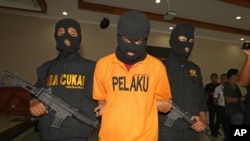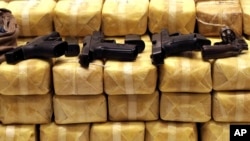Facing an increase in drug trafficking, some Southeast Asian nations are planning on creating a centralized data source for law enforcement and carrying out joint patrols.
Thailand has been playing a central role in promoting the increased cooperation.
Thai Justice Minister Paibul Koomchaya recently told regional narcotics officials, Association of South East Asian Nations (ASEAN) members, donor nations and agencies that there is a need to increase the number of cooperative projects to curb regional narcotics production.
Paibul also called on the region to focus on health care and jobs for drug addicts as part of ASEAN’s 10-year anti-drug action plan.
ASEAN faces a conflicting debate over the policy steps needed to cope with rising production of illicit drugs, largely methamphetamine-type stimulants and heroin. In Thailand, Indonesia and Brunei, methamphetamine use is on the rise. Officials told VOA that heroin is a bigger problem in Indonesia.
Thailand, Laos and Vietnam are attempting to refocus policy towards drug user rehabilitation.
But the crackdown on drug pushers and users by the Philippine administration of President Rodrigo Duterte has left over 3,000 killed and has sparked international condemnation from human rights advocates.
Manop Kamato, an anthropologist in the Faculty of Medicine at Khon Kaen University, who attended the regional officials’ conference, said the meeting promoted more cooperation and assistance given the region’s drug trafficking and social concerns.
“We can go there and we train them to make their own report and try to start to standardize a data base and raise them up equal to other countries,” Manop told VOA.
“Right now we have a problem, yes. Because like Laos, like Cambodia their infrastructure is not so good, so they may take more time – but if we can help, then how do we do it?” he said.
Growing challenge
According to United Nations Office on Drugs and Crime (UNODC) data, South East Asia faces a growing challenge from drug trafficking networks.
The UNODC says seizures of crystal methamphetamine in East and South East Asia have reached historic levels, reaching 30 tons in the past year.
The U.N. drugs body reported methamphetamine seizure levels in 2016 are forecast to rise. Also evident has been a rise in production and trafficking of new psychoactive substances (NPS) – synthetic drugs not yet covered by international controls.
In May, the Mekong Memorandum of Understanding (MoU) on drug control, brought together officials from Cambodia, China, Laos, Myanmar, Thailand and Vietnam – the MoU’s co-signatures – and India, a key source of precursor chemicals needed in drug production.
Chuanpit Choomwattana, a project coordinator on the ASEAN Drug Monitoring Network, says sharing information can play a major role in stemming the flow of drugs in the region.
"If we share information and we cooperate more closely, then we can stop drugs from coming into the region. Most ASEAN identify ourselves as transit countries not the producer and part of the drugs spill-out in the region – so we become the market,” she said.
When seven of the 10 ASEAN countries carried out “self-analysis”, they recognized they were “the transit country and market – they are the victims, not the producer,” she said.
But Chuanpit said there remain substantial information gaps for several countries, undermining policy and drug prevention programs.
“They are very concerned they cannot provide information compared to other countries. And this is one point we can coordinate and support like training for countries that want to improve their capacity in providing this information,” she added.
Joining forces
Thailand, Laos and China have been carrying out joint patrols under the “Safe Mekong Joint Operations”, along the Mekong River bordering Thailand and Laos.
Thailand recently reported the joint operations destroyed a major drug smuggling group of 26 networks across the region.
Jeremy Douglas, UNODC Asia Pacific representative, in emailed comments to VOA said the ‘Safe Mekong’ program provided “operational law enforcement” to the Mekong regional agreement on drug control.
“The overarching drug strategy for the Mekong area supports threat assessments and analysis, development of procedures, and plans for joint or multilateral operations, training and capacity building, across a spectrum of law enforcement, justice and even drug use and health issues,” Douglas said.
UNODC officials say Laos continues to struggle in dealing with drugs as a transit country as well as providing rehabilitation programs.
The Lao government has approved a new drug control master plan to guide policy efforts in the country until 2020.
But UNODC Lao Program Officer Erlend Audunson Falch said the challenge for Laos is that it is a vital transit country for illicit drugs into Vietnam, across land borders with China and Laos.
“Laos has severe challenges both when it comes to drug use, opium cultivation and drug trafficking,” Falch said in emailed comments.
“While these issues are a high priority for the government, there is limited funding available to implement policies,” he said.








